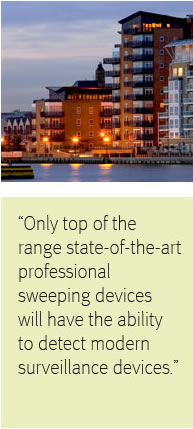TSCM (Technical Surveillance Counter-Measures) is the original United States military abbreviation denoting the process of bug-sweeping or electronic countersurveillance. It is related to ELINT, SIGINT and Electronic countermeasures (ECM).
In today's environment, the furnishing of a Technical Surveillance Counter Measure (TSCM) team is almost an essential proposition for a national security task force.
The United States Department of defence defines a TSCM survey as a service provided by qualified personnel to detect the presence of technical surveillance devices and hazards and to identify technical security weaknesses that could aid in the conduct of a technical penetration of the surveyed facility.
A TSCM survey will provide a professional evaluation of the facility's technical security posture and normally will consist of a thorough visual, electronic, and physical examination in and about the surveyed facility.
The advent of multimedia devices and remote control technologies allow huge scope for removal of massive amounts of data in very secure environments by the staff employed within, with or without their knowledge.
Only top of the range state-of-the-art professional sweeping devices will have the ability to detect modern surveillance devices.
Modern surveillance transmitters often use remote control or store and forward techniques to avoid detection. This can make them more difficult to detect as they may not be actively transmitting when a sweep team is on the premises.
Winkelmann's Rectrix Spectrum Monitoring software allows 24 hour monitoring of the RF spectrum to provide complete protection against these devices. By continuously scanning the spectrum and storing the data gathered to disc, a user can analyse data gathered over days or weeks for intermittent signals.
Winkelmann's Hawk XTS Nljd (non-linear junction detector ) has the capability of locating and confirming the presence of electronic components, regardless whether they are switched on or off.



